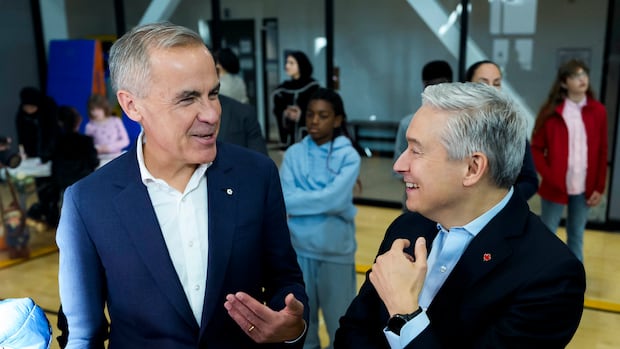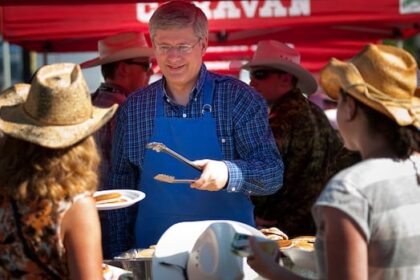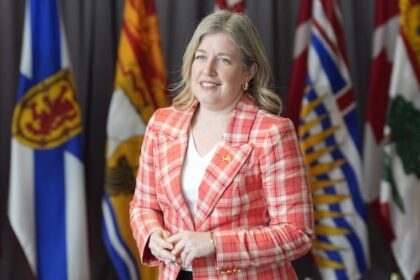Politics·NewAfter weeks of federal government spending announcements leading up to budget day, the biggest unknown remains how large the deficit will be and where and how deep the expected cuts will land.Big spending, cuts and a test for the minority government coming TuesdayKarina Roman · CBC News · Posted: Nov 02, 2025 4:00 AM EST | Last Updated: 30 minutes agoListen to this articleEstimated 6 minutesPrime Minister Mark Carney and Minister of Finance and National Revenue François-Philippe Champagne are set to introduce the federal budget on Tuesday. (Justin Tang/The Canadian Press)After weeks of federal government spending announcements leading up to budget day, the biggest unknown remains how large the deficit will be and where and how deep the expected cuts will land.Prime Minister Mark Carney and his finance minister, François-Philippe Champagne, have repeatedly characterized Tuesday’s budget as a generational one. In this time of “ruptured” global economics and geopolitical uncertainty, the’ve said Canada has to “spend less” to “invest more.” They have spoken of “tough choices” and “sacrifices” that will have to be made, laying the groundwork to brace Canadians for what could be some dramatic numbers.“This is a unique budget because the circumstances necessitate we make some decisions that were not pressing before, the way they are now,” said a senior government official, who was not authorized to speak publicly about the budget. “For decades we relied on a partnership with the U.S. that seemed airtight, but is now fracturing.”WATCH | Carney lays out what to expect in the budget:Carney says budget will focus on building big while cutting wastePrime Minister Mark Carney tried to prepare Canadians for what could be a tough budget with deep cuts and a deep deficit, telling students at the University of Ottawa about how he plans to turn around the country’s weak economy.A recent prime-time speech by Carney framing the budget as one that will empower and protect Canadians while building the country from within has created high expectations.“We’re looking for a serious budget at a serious time,” said Theo Argitis, senior vice-president for policy at the Business Council of Canada.“We don’t have a shortage of ideas. We have a shortage of political courage in this country…. A test for seriousness is whether they are willing to make some trade-offs, prioritize certain things,” he said.All the talk about “building Canada strong” has some stakeholders hopeful for a focus on building domestic capacity, not simply chasing more foreign business investment such as multinational-owned EV battery plants.“My heart would sink if we saw … billions of dollars going towards programs and initiatives that don’t advance our economic strength and our sovereignty. That would be a huge red flag,” said Benjamin Bergen, president of the Council of Canadian Innovators (CCI).“Our view is that economic strength comes from domestic firms that are scaling and growing.”Bergen says that while the government has been tight-lipped on what’s actually going to be in the budget, the CCI has never had more engagement with Ottawa on building domestic capacity as it has in the last three months.Some hints at what’s insideThere have been several pre-budget announcements, as far back as June that include but are not limited to:$9 billion on defence to be spent by the end of March.$13 billion (initially) for the Build Canada Homes agency.$2 billion for small nuclear reactors at Darlington, Ont.$5 billion for a new Strategic Response Fund.$3.6 billion over three years for temporary EI measures due to tariff uncertainty.$1.8 billion to increase federal policing capacity.$370 million for a new biofuel production incentive.$77 million over four years to the CRA for trucking industry non-compliance.$660.5 million over five years for gender equality and safety (including new RCMP hires).$97 million over five years to create a Foreign Credential Recognition Action Fund.$450 million over three years for a workers’ reskilling package.Of course, there will be a number of measures, investments, tax credits and the like that will only be revealed on budget day.Clearly a big increase in defence spending will be part of Tuesday’s budget, with Canada pledging to reach NATO’s target of two per cent of GDP spending by March 31 and 3.5 per cent of GDP on core defence requirements by 2035.“A lot of it’s been very undefined. If there’s no forecast for defence spending beyond this fiscal year, that would be a big concern,” said Dave Perry, president of the Canadian Global Affairs Institute.The budget will be presented differently this year, with operational spending being separated from capital spending. Carney has promised that in three years the operational budget (day-to-day spending on government programs) will be balanced, meaning all deficits will be from expenditures on what the Finance Department defines as “any government expense or tax expenditure that contributes to public or private sector capital formation.”Prime Minister Mark Carney has promised to spend $9 billion on defence spent by end of March 31, 2026. (Christinne Muschi/The Canadian Press)But there will still be one overall deficit number and this year it is expected to be double or more than the $42 billion projected a year ago.“That will be a pretty big number,” said Argitis. “Carney is rationalizing that not all debt is the same. That if you’re using debt to make investments, you can be a little bit less concerned about that. He’s trying to shift the emphasis towards quality of spending.“But at the same time, there are limits to how far he can go.”And Canadians have been warned there will be trade-offs.The senior government source says there will be “transparency” on what is being cut. There will be details beyond percentages that include specifically what reductions mean for particular programs and line items.Could the government fall?Meanwhile, there is uncertainty surrounding the odds Carney’s first budget as prime minister will pass the House of Commons.“There is a scenario where the opposition parties genuinely do not want to support this and would be prepared to roll the dice in an election before they’re seen as being on side of the government,” said Lori Turnbull, a professor of political science in Dalhousie University.Even the NDP, diminished to seven MPs and in the midst of a leadership race, might not want to again be seen as the party that’s propping up the Liberals.WATCH | NDP leadership candidate says party can’t support austerity budget:New Democrats can’t support an austery budget: Heather McPherson | Power & PoliticsNDP MP Heather McPherson says if Prime Minister Mark Carney wants her party to support his upcoming budget, he can’t present an ‘austerity’ budget that includes cuts to the public service and ‘things that Canadians depend on.’“Maybe the NDP would rather hit the pavement … than be anywhere near the budget. It really depends on what the Liberals are asking people to swallow,” said Turnbull.But recent talks between the finance minister and Bloc Québécois Leader Yves François Blanchet have given rise to some speculation the Bloc might not vote against the budget.“I think that the public’s mood for an election is an absolute no,” said Turnbull.ABOUT THE AUTHORKarina Roman is a senior reporter based in Ottawa, covering all things political. After a number of years working in CBC local news and current affairs, she joined the parliamentary bureau in 2008. Her beat is finance, which means she has reported on and tried to explain to Canadians almost every federal budget, economic update, finance ministers’ meeting and the like for more than a decade. Before her career at CBC, she worked at The Ottawa Citizen and The National Post. You can email her at karina.roman@cbc.ca.
Sunday, 2 Nov 2025
Canada – The Illusion
Search
Have an existing account?
Sign In
© 2022 Foxiz News Network. Ruby Design Company. All Rights Reserved.
You May also Like
- More News:
- history
- Standing Bear Network
- John Gonzalez
- ᐊᔭᐦᑊ ayahp — It happened
- Creation
- Beneath the Water
- Olympic gold medal
- Jim Thorpe
- type O blood
- the bringer of life
- Raven
- Wás’agi
- NoiseCat
- 'Sugarcane'
- The rivers still sing
- ᑲᓂᐸᐏᐟ ᒪᐢᑿ
- ᐅᑳᐤ okâw — We remember
- ᐊᓂᓈᐯᐃᐧᐣ aninâpêwin — Truth
- This is what it means to be human.
- Nokoma












